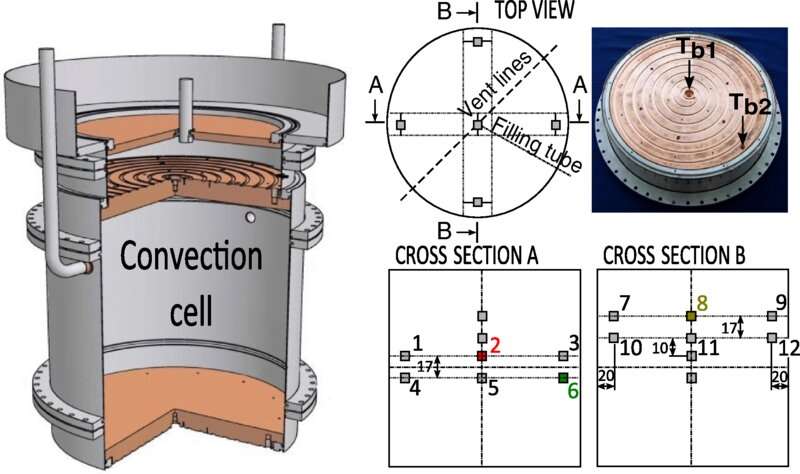April 27, 2022 report
Heat flow shown to be more efficient when temperature is oscillating than when static

A team of researchers from the Institute of Scientific Instruments working with a colleague from Charles University, both in the Czech Republic, has shown that heat flows more efficiently when the temperature of the material through which it is flowing oscillates, as opposed to remaining steady. In their paper published in the journal Physical Review Letters, the group describes experiments they conducted with heating and cooling helium in a container and its relevance to a theory proposed just two years ago.
In 1916, physicist John William Strutt, 3rd Baron Rayleigh, showed an example of oscillating heat flow. He filled a container with a fluid and then placed a heated coil below it and a cooling plate on top. This forced the liquid to rise and fall in the container. The effect has come to be known as Rayleigh-Bénard convection—it can be seen in the action of lava lamps. Two years ago, a team at the University of Twente proposed that heat flow in a Rayleigh-Bénard convection system would be more efficient if the heat coming from the base was oscillating. In this new effort, the researchers have shown this theory to be correct.
The work involved creating a container with a heating device at the bottom that could move through a temperature gradient over time. And like Strutt, they placed a cooling device on top. Unlike Strutt, however, they used a gas rather than a liquid—in their case, helium. They also carried out their experiments under cooler than ambient temperatures. To learn more about the impact of such oscillations on the heat flowing through the system, they conducted multiple runs during which the speed at of the oscillations ranged from 0.006 to 0.2 Hz.
They found that, as predicted, an oscillating heat source moved heat through the system more efficiently—as much as 25% more. Earlier theory suggested that the improvement in efficiency arises due to a destabilization between the boundaries of the liquids in the chamber, allowing the liquid areas in them to move past one another more easily.
More information: P. Urban et al, Thermal Waves and Heat Transfer Efficiency Enhancement in Harmonically Modulated Turbulent Thermal Convection, Physical Review Letters (2022). DOI: 10.1103/PhysRevLett.128.134502
Journal information: Physical Review Letters
© 2022 Science X Network





















